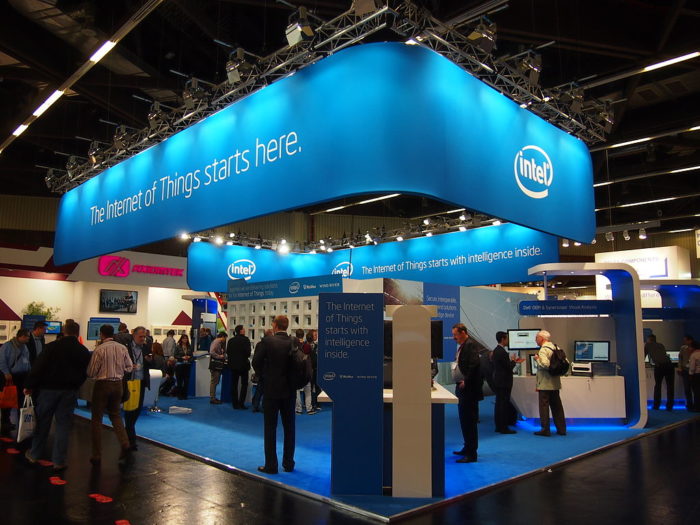
Image Credit: Wikimedia Commons
The International Builders’ Show is a favorite venue for manufacturers introducing new tools and building products. The annual show, which just opened in Las Vegas, will draw tens of thousands of building professionals before it ends on Jan. 22.
A home show of a different kind opened a few weeks earlier, also in Las Vegas. But instead of I-joists and plywood, it was the “Internet of Things” — the digital world connecting appliances, mechanical systems and other home goods via the internet — that was on display at the Consumer Electronics Show.
According to a report posted at ConstructionDive.com, the show featured a variety of new products that connect homeowners to everything from lawn sprinklers to coffee makers and thermostats.
Far from a passing fad, interconnected security and energy systems will amount to a $574 million industry this year, an increase of 23 percent over 2014, the report says.
What these devices can do
The Nest learning thermostat is emblematic of what the Internet of Things will be able to do for people. But it’s just the beginning. Products can be linked in a number of not altogether intuitive ways, communicating with each other directly rather than getting instructions from a central hub.
For example, this year’s Consumer Electronics Show featured a control system that connected lawn sprinklers with a coffee pot. Why? An empty coffee pot signals the sprinklers to stop sprinkling so that anyone walking out the door to go to work won’t get soaked.
Some features are more practical.
A lighting device, ConstructionDive reports, is capable of learning daily household patterns so it can set itself to turn lights on just before the family gets home, or turn on a low light when someone gets up in the middle of the night to use the bathroom.
Whirlpool showed off an internet-connected clothes dryer that can run in an energy-saving mode when no one is home and dry clothes aren’t needed immediately. How does it know? It’s linked to the Nest thermostat, which has turned down the heat because everyone in the family is at work or at school.
The same thermostat can instruct window shades to roll down and block the sun when indoor temperatures get too high.
A connected door lock could be programmed to recognize a homeowner’s face and unlock doors automatically, Intel CEO Brian Krzanich told The Fresno Bee.
“I don’t have to program that,” technology consultant Tom Kerber told the newspaper. “The devices are talking to each other and making those smart decisions on your behalf.”
There are still a few roadblocks
Manufacturers face a number of challenges in getting interconnected devices into more homes.
For one thing, they’re expensive. The Nest thermostat costs $250; the competing Lyric from Honeywell is almost as much. Wi-Fi connected appliances are much more expensive than their conventional counterparts.
As Fortune magazine points out, the devices make the most sense in new homes, but home ownership is declining.
Second, there’s no common digital language between devices. Hub devices can solve that problem by translating protocols, but a new problem is that any number of companies want to “establish themselves as the primary gatekeeper for the Internet of Things,” as The Bee put it.
So, Honeywell’s Lyric smart-home devices won’t talk to Nest thermostats or smoke detectors, the newspaper said. Apple’s home automation platform, called HomeKit, is competing against Samsung’s SmartThings.
“Everything at this point is completely fractured,” said technology consultant Patrick Moorhead, “and that’s going to limit growth until people can play more nicely together.”
Finally, there’s the problem of the backlash against smart appliances from homeowners with privacy concerns. For more information on the anti-smart-appliance backlash, see Martin Holladay’s report, Get Ready for Smart Appliances.
Weekly Newsletter
Get building science and energy efficiency advice, plus special offers, in your inbox.












4 Comments
Its a wonderfull world but
Its a wonderfull world but what are you going to do when someone hacks your internet connected home and turns on your furnace in July and turns off your refrigerator. Then they start your sprinklers at a time the eco-nazi's deem inappropriate and you get arrested. If people feel violated when the get their identity stolen, how are they going to react when someone takes control of their home and uses it as a weapon against them?
Stop with the "Internet of things"
The saying the "internet of things" is probably the dumbest sounding thing I've heard in awhile. Too forced sounds like someone trying really hard to make up a catch phrase, a lot like of Mike Meyers in the "Love Guru."
Problems
Both our society and the building industry face real challenges. I wish someone could explain to me how automating more functions in a house solve any of them.
wired home
I think I'll install the control panel right next to my VCR, so they can blink "00:00" in unison.
Log in or create an account to post a comment.
Sign up Log in